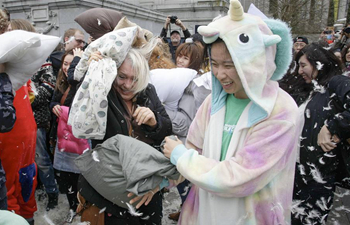WASHINGTON, April 10 (Xinhua) -- American researchers have developed a genetic screening tool that identified two key factors that allow the influenza virus to infect human lung cells.
The study, published on Tuesday in the journal Cell Reports, revealed a technique that can create a library of modified cells, each missing a different gene, allowing scientists to see which changes impact their response to flu. This in turn could identify potential targets for antiviral drugs.
"Our current treatments for flu are limited. Vaccines have variable efficacy, and the virus has a propensity to mutate so that antiviral drugs don't work as well," said Julianna Han, a graduate student in microbiology at the University of Chicago and lead author of the study.
"The next wave of antiviral treatments will be in part directed toward the host, so our work helps us get a better understanding of what proteins and pathways are utilized by the influenza virus."
Han and Balaji Manicassamy, assistant professor of microbiology and the senior author of the study, used CRISPR/Cas9 gene editing tools that allow scientists to selectively knock out, or turn off, specific genes.
They created a library of modified human epithelial lung cells, the cells that line the airways and are the first to be infected by the flu virus. Each cell was missing a different gene, creating nearly 19,000 different genetic variations of the cell.
The researchers then exposed the cells to the H5N1 flu strain, a type of influenza A virus commonly known as the bird flu.
They supposed that if the virus was able to infect and kill one of the host cells, that means the gene and the proteins it produces didn't play a role in the virus' ability to replicate.
If the cell survived, that means its modified genome somehow made it resistant to the virus, it was now missing a pathway that the virus relied on to replicate and do its dirty work.
After five rounds of exposing the cells to the H5N1 virus, the researchers were left with a set of cells that were pretty resistant to the flu. When they examined what these hardy survivors had in common, two genes stood out.
One, SLC35A1, encodes a protein that helps create a receptor for the flu on the surface of the cell.
The second gene, CIC, is a negative regulator of the innate immune system, meaning it helps shut down the cell's default immune response to foreign invaders.
When CIC is turned off, other genes that produce antiviral and inflammatory responses are allowed to fire up and fight off the virus, which is why the test cells missing it were resistant to the flu.
But researchers said one couldn't just knock out a gene like CIC permanently as a means to fight the flu. The body needs mechanisms to shut off the immune system once an infection is gone. If not, it could go into overdrive and damage the body's own cells, which is what happens in autoimmune disorders.
On the other hand, certain cancers can exploit a negative regulator like CIC to suppress immune responses while tumor cells run rampant.
Once identifying the two key genes involved in H5N1 response, they exposed the cells to other pathogens to spot any more commonalities.
CIC was also important for all strains of flu and several RNA viruses, or viruses containing RNA genomes. These included respiratory and non-respiratory viruses, highlighting CICs broad effect.













